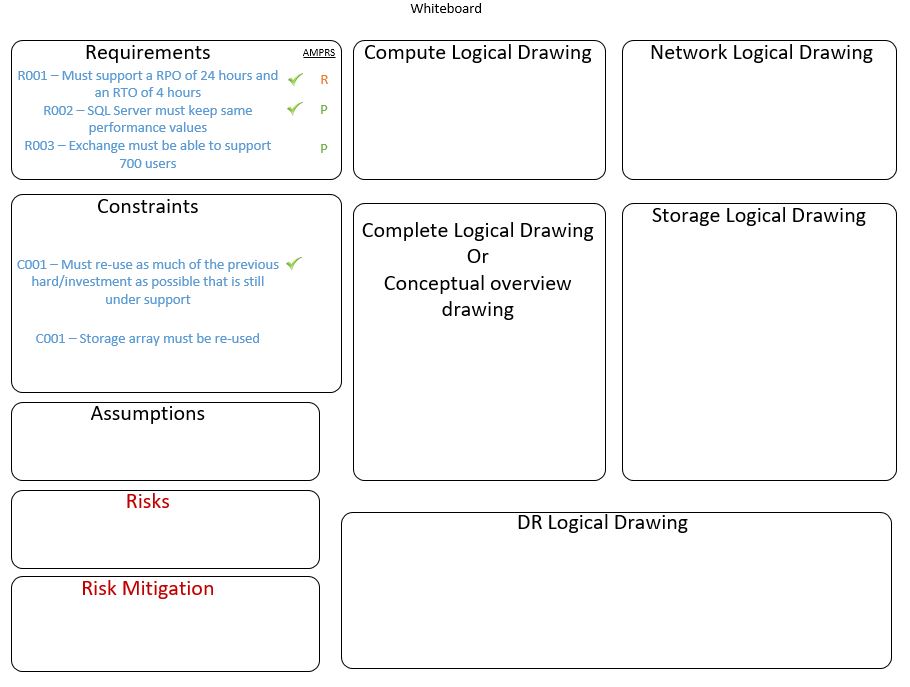
Hey,
Just wanted to make a quick blog post around some tips and tricks around the mock design question in the VCDX exam. In the past this gets over looked due to prioritizing your presentation or not practiced enough. I get a lot of feedback from VCDX candidates either stating this is where they felt they fell a little short in their first defense, or I get a lot of questions on how to attack it.
My aim for this blog post is to help give some tips from my experience on how to attack the mock design question and as always generate conversation some good conversation around it. As the more ways you see people attack it the better you yours will be.
With that said this is how the question will shake down. You will come back from your break and there will be a mock design question on the laptop provided. The proctor will go over the rules of this session of the exam and you will be okay to proceed. The timer doesn’t start until you ask a question. So if you need to read through the question a few times before starting do so.
The question will give you the scenario / problem / project the “company” is having, some requirements, constraints, and technical specifications of the gear they currently have. The goal of this part of the exam is to see if you can go through the design process learned in the VCDX by pulling out the vital information provided and talking to the “SME’s AKA VCDX panelists” to extract any further information to form a valid design while adhering to the standards set in the VCDX program. This being making good design decisions linking back to the customers’ requirements, constraints, assumptions, while applying AMRPS(Application, Manageability, Recovery, Performance, Security) and mitigating any risk. Any risk shown needs to be discussed, mitigated if possible, or signed off on by the panelists just like a real project/customer. The panelists are also looking for good personal skills. Just pretend you are at one of your customers.
I don’t have any examples of a mock design question as I’m on the road but I have bunch from when I was practicing that I could share once I’m back home. So I’ll make sure to update the post then and get those up here
So how to attack it. Now there is no silver bullet for this or “one way” so this is how I would typically tackle it or is advice I give out when mentoring people on this subject. Again any advice or better/ other ways you think would work better is always welcome.
Step 1.) USE UP AS MUCH as the whiteboard as you can. This is crucial and they are looking for this. I will get more into this shortly.
Step2.) If you need to run some numbers or calculate something and you are not sure if you are crunching it in your head correctly, you can ask the panelists to calculate something for you. You can also ask them to look something up for you but I would try and minimize this as much as possible. An example of this could be a SQL licensing question and you just need to make sure the licensing format you went with in your design will have the features you are looking for etc.
So once you have read the question start writing any points up on the board. Keep in mind asking a question or writing on the board will START the timer. I typically would cut the white board up in chunks as seen in the picture below and as I worked through different areas of the design I would put those up on the board.

So right off the bat from reading the question you can pull some requirements and or constraints down and get them up on the board. Possibly some current hardware or any technical specs you may have to work with. You can then start asking questions of the SME’s (You’re wonderful VCDX panelists) and getting high level goals of the project or any other requirements, constraints, assumptions, risks ,etc. Some typically questions you could ask to help get the high level information:
- What is the end business state or goals for this project
- What would deem this project successful
- What was the catalyst for starting this project
Now from here you should have enough information that you could draw a conceptual design on the board somewhere and ask everyone if this fulfills the requirements of the project from a high level. With that said time is your enemy as you only get 45min so I typically kept it mostly logical design, but it is important to get a consensus on the end goal.
Then start drilling into sections and making design decisions. I typically start with Compute and Storage as these are usually big pieces of the design. When making design decisions for each section remember whiteboard as much as possible and show them the pro’s / conc’s of your design decision. You may have to show them 2 or 3 other options or ways of accomplishing their goals and then make a decision. Remember you want sign off from the customer (VCDX panlists) but at the end of the day YOU have to make the decision! You are the architect they have hired to look out for their best interests so if there is any indecision on the panel tell them design option 1 is the one we will go with and here is why. Here is your requirements, constraints, met and risks if any mitigated. Once you have that design decision locked in get it up on the board and erase any other designs, etc for whiteboard space as you will need it.
Pick your next section and rinse and repeat until you get through all the sections. Now one thing to note is I haven’t ran into many VCDX’s that have actually finished the design in that time period. The reason for this is 45 min to get an entire design done is just not enough time in most cases. What they are doing is looking for your design skills, thoughts, customer skills, white boarding skills, and most importantly opportunities to score more POINTS. So remember if you feel you scored poorly in one of your sections in your design/presentation this is a great place to make up those points. The panelists will also typically try and drive you to those points. So if they are asking you questions about something make sure to answer them well and scope up those points as there is a good reason as to why they are asking you those questions.
Well I hope this has helped give some tips, tricks, and helpful insight to this part of the exam. Any advice is always welcome to always help improve.
Thanks again!

I think you are overestimating the information provided by the initial slides.